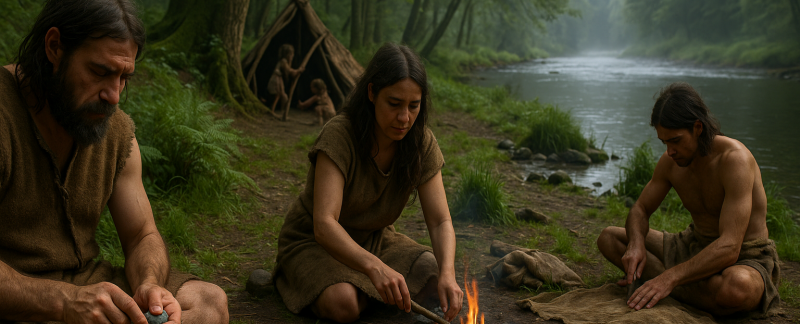Palaeolithic Age Ireland opens a fascinating yet puzzling chapter in the island’s deep past, blending the broader Old Stone Age with early human arrivals, ancient stone tools, and nomadic hunter-gatherers on Irish soil. For a long time, experts believed humans only reached Ireland during the Mesolithic period (around 8000 BC). However, recent discoveries have reshaped that view, pushing Ireland’s timeline deeper into the shadows of the Paleolithic Age.
The Oldest Evidence of Early Humans
The Palaeolithic Age stretches from roughly 2.5 million years ago to about 8000 BC. For Ireland, the earliest confirmed human evidence is surprisingly recent compared to other parts of Europe.
In 2016, archaeologists unearthed a bear bone with cut marks, dated to approximately 12,500 years ago, inside the Alice and Gwendoline Cave in County Clare. This discovery suggests that human presence came much earlier than previously believed. Before this, there had been no clear proof of Paleolithic people here. This single finding has opened new doors and raised fresh questions about Ireland’s earliest visitors.
Life in an Ice Age Landscape
Imagine Ice Age Ireland 12,500 years ago:
- Vast ice sheets dominated the land,
- Tundra landscapes stretched across the south,
- Herds of woolly mammoths, reindeer, and arctic foxes roamed freely.
Although the last Ice Age was drawing to a close, Ireland remained rugged and cold. Early humans likely crossed from Britain or continental Europe when lower sea levels created land bridges. They were probably tracking prey animals and moving with the seasons, adapting to the harsh conditions.
Tools and Survival Strategies
Ireland’s earliest people were master survivalists. They crafted:
- Flint blades and scrapers for hunting and butchering,
- Bone and antler tools for essential tasks,
- Likely wooden spears and other perishables (though rarely preserved).
No large Paleolithic tool sites have yet been uncovered here, but evidence from Britain and Europe helps us imagine similar lifeways. Early groups likely moved in small bands, setting up temporary camps near water or shelter.
Myths and Lost Histories
Unlike later Celtic or Viking periods, the Paleolithic leaves no traces in Irish myth or folklore. Yet this absence sparks imagination:
- Could there have been lost communities, their stories drowned by rising seas?
- Might submerged landscapes beneath the Irish Sea once have been rich with human activity?
As the Ice Age ended, rising seas likely submerged vital coastal evidence, erasing clues to early migrations.
Scientific Breakthroughs in Paleolithic Research
Thanks to modern archaeology, more light is shining on Paleolithic Age Ireland. Techniques like:
- DNA analysis of ancient remains,
- Improved radiocarbon dating,
- Underwater archaeology of submerged sites,
are helping uncover how and when people first arrived. The butchered bear bone in County Clare sparked new debates: were these visitors passing through, or did they settle? Could future digs reveal stone tools, hearths, or human remains?
Why Paleolithic Age Ireland Still Matters
Every discovery pushes the timeline of Ireland’s human history further back.
- It reshapes how we understand migrations,
- It connects Ireland to the broader Ice Age story,
- It shows how even small finds — a bone, a tool — can transform our understanding of the past.
Palaeolithic Age Ireland is no longer a blank page. Instead, it is a faint but growing chapter, waiting to be fully explored by future generations.

